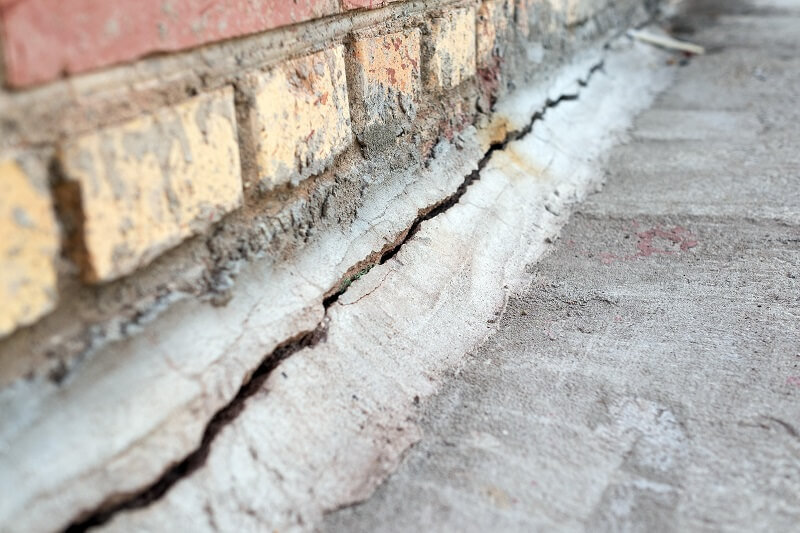
If you’ve ever noticed a crack in your concrete foundation, you know how unsettling it can be. It’s essential to take action and repair the break as soon as possible before it gets worse. After all, maintaining your home is a great way to increase its value.
Fortunately, fixing a mild foundation crack is usually a simple weekend project that can be done with suitable materials and knowledge. With some basic DIY skills, you can quickly fix the damage and regain peace of mind as a homeowner.
Foundation cracks can indicate severe structural damage and should not be ignored. Mild foundation cracks can lead to further problems such as water damage, mold growth, and even more severe cracking.
If you’re looking for a way to fix mild foundation cracks in your house, look no further! You can quickly repair these cracks with the right tools and knowledge.
Identifying Source of Crack
Identifying the source of foundation problems can be tricky, but it’s essential to do so to determine the best course of action. Foundation cracks can be caused by various factors, from lousy soil to weather changes.
To find the source of the damage, it’s important to look at the type of crack, its location, and any other signs that could indicate what is causing it.
Types of Cracks
Foundation cracks can come in various shapes and sizes, each indicating different levels of severity. Here are some of the most common types of foundation cracks:
- Horizontal Cracks: These are serious and typically indicate structural damage.
- Stair Step Cracks: These form along mortar joints and can be caused when the soil shrinks or expands.
- Hairline Cracks: These are usually minor, but they may need to be addressed if they become more prominent.
- Vertical Cracks: These usually indicate typical foundation settlement or compression and tension on the concrete.
- Diagonal Cracks usually signify a settling foundation and should be monitored closely.
Identify Severity
Here are some key points to look for when assessing the severity of a foundation crack:
- Diagonal cracks that run from about 30-75 degrees from vertical on your foundation or basement wall
- Patterns that indicate a shift in the foundation
- Small cracks that appear in multiple places
- Minor settlement damage that causes cracked floors and walls
- Water seeping through any minor cracks in the foundation wall
Horizontal cracks are usually more severe than vertical or stair-step cracks, indicating structural damage. Hairline cracks may also be cause for concern if they start to widen over time and affect the structural integrity of your home.
If you notice any water seepage or wet spots around the foundation, this could indicate that your foundation is not properly draining and could lead to further damage.
By taking note of these signs, you can better identify the source of a mild foundation crack and take steps toward fixing it.
Fixing the Foundation Crack
Foundation cracks can be significant, but some DIY solutions can help with minor damages. Here are some of the most popular methods for fixing foundation cracks:
Epoxy Sealer
Using an epoxy sealer to repair a foundation crack is a simple process that can be done by both DIYers and professionals alike. Here’s how:
- Purchase an epoxy concrete crack repair kit.
- Clean the area around the crack with a wire brush to remove dust or debris.
- Prepare the epoxy according to the instructions in the kit and inject it into the crack using a caulking gun.
- Allow the epoxy to dry completely before applying a sealant over the top of it.
- Apply a sealant over the top of the dried epoxy to ensure that no water or radon gas can penetrate through the crack.
Epoxy injection
Epoxy injection is a reliable way to repair foundation cracks. Here are the steps for using an epoxy injection:
- Inspect the crack and make sure it is dry before beginning the repair.
- Prepare the crack by cleaning it with a wire brush and vacuum out any debris.
- Mix the epoxy according to the instructions on the package.
- Inject the epoxy into the crack using a caulking gun.
- Allow the epoxy to cure completely before applying additional coats of sealant or paint, if desired.
Cement paste
Using cement paste to repair a foundation crack is a relatively simple process that can help prevent further damage and costly repairs. Here are the steps to follow:
- Clean the crack thoroughly with a wire brush or vacuum to remove debris.
- Apply a concrete bonding agent to the surface of the crack.
- Fill the crack with an epoxy or polyurethane foam injection kit, following the manufacturer’s instructions.
- Allow the material to cure according to the manufacturer’s instructions.
- Apply a cement paste over the cured material using a trowel or putty knife.
- Smooth the paste and allow it to dry completely before adding additional coats.
Polyurethane
Using polyurethane to repair a foundation involves the following steps:
- Drill small holes into the foundation.
- Inject high-density polyurethane foam into the drilled holes.
- The foam will expand and fill any cracks or voids in the foundation.n
- Allow the foam to cure for 15 minutes, after which it is traffic ready.
- Seal off the injection points with a masonry patching compound
Carbon Fiber Straps
Carbon fiber is an excellent option for repairing foundations due to its strength and durability. Here are the steps to use carbon fiber for foundation repair:
- Measure the area of damage and determine the number of straps needed.
- Cut the carbon fiber straps to size, dip them in epoxy, and smooth them over the crack.
- You can safely attach the straps to the wall at intervals determined by the type and severity of the damage.
- Allow the epoxy to cure before applying additional coats or layers of material.
- Inspect regularly to ensure that repairs are holding up well.

When To Call A Professional
Foundation wall cracks can signify severe structural damage, so knowing when to contact a professional is important. If you notice any horizontal or stair-step cracks, or if the crack is wider than 1/4 inch, it’s time to call in an expert.
Additionally, if the crack changes direction or appears in multiple places around your foundation, it could indicate a more severe problem.
It’s also important to watch for other signs that your foundation may need repair. These include doors and windows that are difficult to open and close, sloping floors, and cracked walls or ceilings.
If you need clarification on whether your foundation crack is cause for concern, it’s best to consult a professional who can assess the situation and advise on how best to proceed.
Professional Foundation Inspection
A qualified structural engineer or inspector conducts an inspection to determine the extent of any damage or structural problems with the foundation and provides recommendations for repairs, if necessary.
The inspection typically includes:
- Visual inspection of the foundation walls, floors, and other components
- Measurement of wall movement and cracking
- Checking for signs of water damage, moisture accumulation, and structural issues
- Evaluation of drainage systems and grading around the house
- Assessment of soil conditions around the foundation
- Evaluation of any existing repair work
Resolving Any Potential Future Damage
Foundation damage can be a costly and time-consuming problem to repair. Fortunately, you can take steps to prevent future damage to your foundation. Here are some tips:
- Clean gutters and downspouts regularly to ensure proper drainage away from the foundation.
- Grade the soil around the foundation so it slopes away from the house.
- Install drains for waterproofing the foundation.
- Water dry soil during dry spells to maintain moisture levels.
- Plant trees at least 10 feet away from your home’s foundation.
- Monitor for drainage problems, such as pooling water or leaking downspout.
- Avoid overloading your soil with heavy objects, like large planters or vehicles.
- Regularly inspect your home’s foundation to identify any potential issues early on.
Documenting Foundation Crack Repair
When documenting your foundation crack repair, include details such as the material used, any additional repairs made, and any safety precautions taken during the process. It’s also helpful to take photos throughout the repair process so you have a record of what was done.
Conclusion
If you have a mild foundation crack, you can use several repair techniques to fix it. For minor cracks, caulking or epoxy injection may be enough to seal the crack and prevent further damage.
No matter what technique you choose, it’s important to consult a professional if the crack is more than 1/4 inch wide or if it runs along a joint in your foundation wall. A professional will be able to assess the severity of the problem and recommend an appropriate solution.
Selling a house with foundation issues to cash buyer home buyers in Texas can be an excellent option for those looking to quickly and easily sell their property. Cash buyers often overlook minor foundation issues, allowing you to avoid costly repairs or renovations.
Whether you need to sell a house fast in Wichita Falls or locate a buyer who advertises “we buy houses Arlington,” a cash buyer can close the sale quickly, meaning you can move on from your property without delay.
